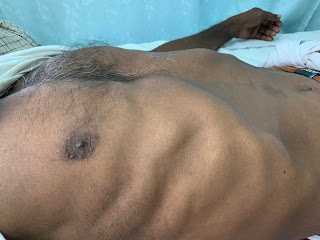Bi monthly assessment
CASE 1:
1) Patient develops hypoalbuminemia due to liver pathology as liver helps in albumin synthesis. Oncotic pressure is reduced leading to accumulation of fluid. So patient developed Ascites due to loss of starling forces
2)
a) The pedal edema may also be explained by the hypoalbunemia hypothesis. But it can also be explained in terms of increased pressure in the abdomen in gross ascitis which may have caused obstruction to the lymphatic vessels and causing pedal edema (this is mostly supported for unilateral pedal edema)
b) in case of pedal edema there is stretching of skin and cracking up this may alter the defence mechanisms of skin. pathogens lodge and may develop infections, cellulitis of the leg.
c) At the same time due to increased stretching of the skin the upper epidermis gets separated and leads to accumulation of fluid there, which is the reason for blebs.
d) When there is excessive stretching there will be more pressure which may lead to pressure necrosis and cause ulcerations.
3)
a) Asterexis and constructional apraxia are seen in cirrhotic patients who may have landed in encephalopathy. This may be attributed to the ammonia metabolism which is not well metabolised due to liver failure leading to increased ammonia levels in the brain causing the above mentioned conditions.
b) they may have thought of syp. Lactulose which is usually given in a case of hepatic encephalopathy which decreases blood ammonia content in the body and also syp. Hepamerz which reduces the accumulations of ammonia in the body.
Use and overuse of proton pump inhibitors in cirrhotic patients
https://pubmed.ncbi.nlm.nih.gov/18758417/
Proton pump inhibitor use significantly increases the risk of sp
https://pubmed.ncbi.nlm.nih.gov/25078671/
CASE 2:
1)one of the major side effects of ATT drugs is hepatitis. So as the patient is already in the stage of liver failure , if we give ATT it may worsen the liver condition. So they may have stopped giving ATT therapy.
2)sputum positivity
ESR will be increased generally(not given here) but not specific for Pulmonary TB
Military tuberculosis findings of X-ray (which is not see here)
Pleural effusion is given(one of the cause is TB) and that too unilateral.
3)The cause of ascitis here may be either of the one below
a) due to cirrhosis of liver
b) tuberculosis (extra pulmonary) causing acsitis.
Proton Pump Inhibitors Increase Risk for Hepatic Encephalopathy
Evidence:
https://pubmed.ncbi.nlm.nih.gov/27639806/
Proton pump inhibitor use significantly increases the risk of sp
https://pubmed.ncbi.nlm.nih.gov/25078671/
CASE 3:
1)a) As the investigations are observed the platelet count is decreasing gradually. So we have to take platelets count into consideration and look out for bleeding manifestations. And if required platelet infusion is given.
b) And by light microscopy and electron microscopy we can know which type of gloemrular pathology that is leading to these presentation. And also there is no hematuria which supports nephrotic syndrome diagnosis. And also hypoprotenemia hypo albuminemia also supports the diagnosis of nephrotic syndrome.
2) a) renal biopsy can give the more conclusive evidence for the diagnosis which is included in the pros
b) cons include pain at the site. Infections if the area is not properly sterilized.
c) According to the diagnosis we can give treatment.


Comments
Post a Comment